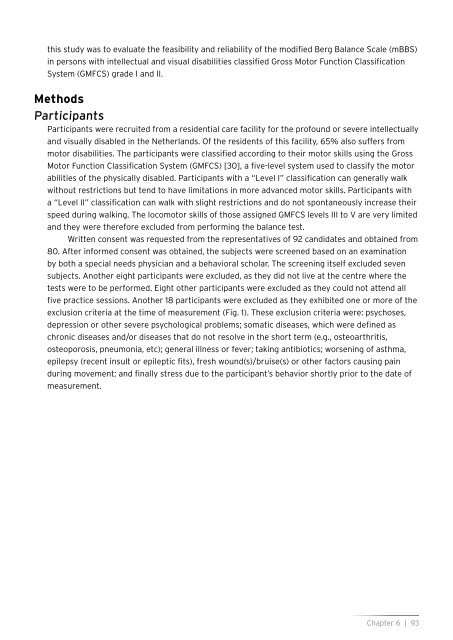Measuring physical fitness in Persons with Severe/Profound ...
Measuring physical fitness in Persons with Severe/Profound ...
Measuring physical fitness in Persons with Severe/Profound ...
- No tags were found...
Create successful ePaper yourself
Turn your PDF publications into a flip-book with our unique Google optimized e-Paper software.
this study was to evaluate the feasibility and reliability of the modified Berg Balance Scale (mBBS)<strong>in</strong> persons <strong>with</strong> <strong>in</strong>tellectual and visual disabilities classified Gross Motor Function ClassificationSystem (GMFCS) grade I and II.MethodsParticipantsParticipants were recruited from a residential care facility for the profound or severe <strong>in</strong>tellectuallyand visually disabled <strong>in</strong> the Netherlands. Of the residents of this facility, 65% also suffers frommotor disabilities. The participants were classified accord<strong>in</strong>g to their motor skills us<strong>in</strong>g the GrossMotor Function Classification System (GMFCS) [30], a five-level system used to classify the motorabilities of the <strong>physical</strong>ly disabled. Participants <strong>with</strong> a “Level I” classification can generally walk<strong>with</strong>out restrictions but tend to have limitations <strong>in</strong> more advanced motor skills. Participants <strong>with</strong>a “Level II” classification can walk <strong>with</strong> slight restrictions and do not spontaneously <strong>in</strong>crease theirspeed dur<strong>in</strong>g walk<strong>in</strong>g. The locomotor skills of those assigned GMFCS levels III to V are very limitedand they were therefore excluded from perform<strong>in</strong>g the balance test.Written consent was requested from the representatives of 92 candidates and obta<strong>in</strong>ed from80. After <strong>in</strong>formed consent was obta<strong>in</strong>ed, the subjects were screened based on an exam<strong>in</strong>ationby both a special needs physician and a behavioral scholar. The screen<strong>in</strong>g itself excluded sevensubjects. Another eight participants were excluded, as they did not live at the centre where thetests were to be performed. Eight other participants were excluded as they could not attend allfive practice sessions. Another 18 participants were excluded as they exhibited one or more of theexclusion criteria at the time of measurement (Fig. 1). These exclusion criteria were: psychoses,depression or other severe psychological problems; somatic diseases, which were def<strong>in</strong>ed aschronic diseases and/or diseases that do not resolve <strong>in</strong> the short term (e.g., osteoarthritis,osteoporosis, pneumonia, etc); general illness or fever; tak<strong>in</strong>g antibiotics; worsen<strong>in</strong>g of asthma,epilepsy (recent <strong>in</strong>sult or epileptic fits), fresh wound(s)/bruise(s) or other factors caus<strong>in</strong>g pa<strong>in</strong>dur<strong>in</strong>g movement; and f<strong>in</strong>ally stress due to the participant’s behavior shortly prior to the date ofmeasurement.Chapter 6 | 93











